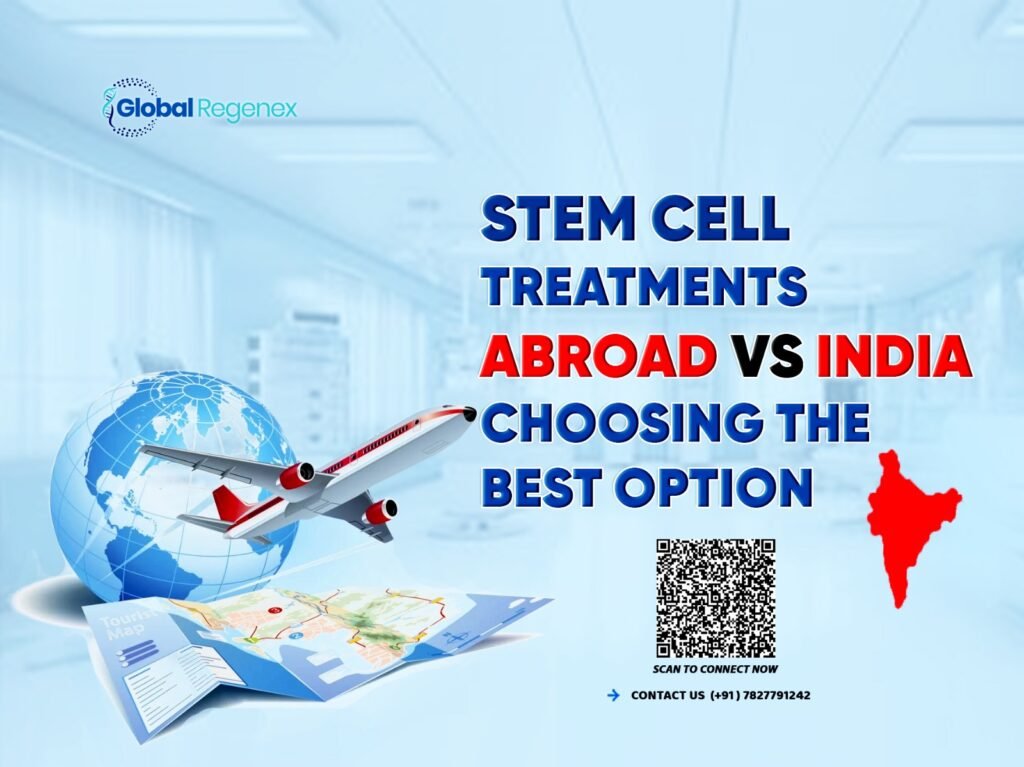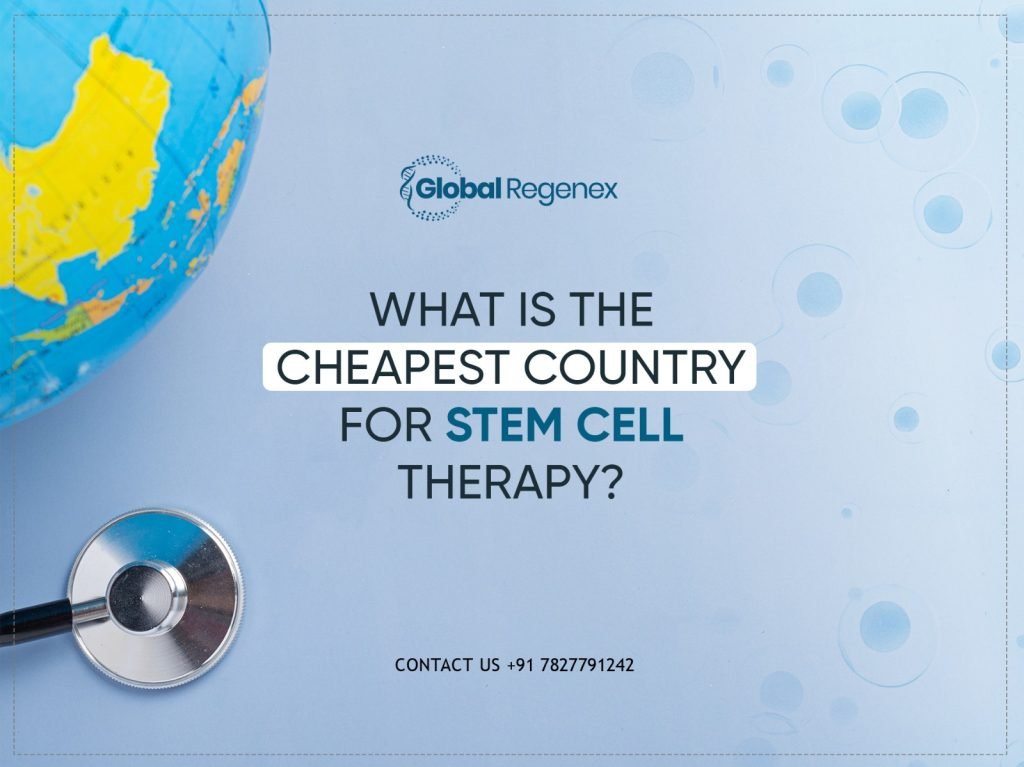Stem Cell Treatments Abroad vs India: Choosing the Best Option

Summary: Stem cell therapy has revolutionized the field of medicine, providing innovative solutions to patients suffering from long-lasting diseases and injuries. India is the center of the world that not only meets but also exceeds the expectations of patients by offering cutting-edge medical expertise, state-of-the-art facilities, practicing good ethics, and reasonable costs. This blog is an investigation into how India has become the go-to place for stem cell therapies that are both reliable and effective. Are you considering stem cell therapy and not sure if you should go abroad or stay in India? Millions of people worldwide are seeking regenerative therapy to be cured of the aforementioned ailments. Seriously, the other Western countries are still working on the scene in terms of medical breakthroughs, but India has made a landmark progress in the field of stem cell treatment, which is safe, affordable, and driven by research. India is leveraging the latest scientific advances with excellent patient care, making it possible for the patients to have the benefit of international quality standards at substantially lower prices. Overview of Stem Cell Therapy Stem cell therapy is a procedure that includes the use of unique cells in the body that have the power to regenerate and repair damaged tissues. These cells can become muscle, bone, nerve, or blood cells, thus aiding the body in recovering from the inside. Such treatment is progressively being utilized to ameliorate the following diseases or conditions: Orthopedic Disorders: Osteoarthritis, ligament tears, sports injuries Neurological Issues: Cerebral palsy, Parkinson’s disease, spinal cord injuries Chronic Illnesses: Diabetes, heart diseases, autoimmune disorders Skin and Wound Care: Diabetic ulcers, burns, and scar repair The country of India has implemented stem cell research and clinical procedures that are ahead of time. This ensures that the patient’s condition determines the safety, regulation, and customization of the treatments. Why Do People Often Go Abroad for Treatment? As the patient finds out that the conditions are serious, they often look for countries with better treatment. Numerous patients at the beginning go to Western countries for medical treatment because: The idea of advanced infrastructure and high technology Impact of promotion by international clinics Trust that treatments abroad are more effective Nevertheless, such choices are frequently too expensive to be accessible and involve complicated mobility and authorization protocols. Gradually, the patients have come to the point where they have recognized that India provides the same worldwide standard of medical care, quite often, the same doctors who are trained abroad, but at a fraction of the cost. India as a Pivotal Point for Advanced Stem Cell Therapy Here are some reasons why India is the perfect destination for patients seeking stem cell treatment in India: Advanced Medical Infrastructure Hospitals and clinics in India are outfitted with cutting-edge facilities, ISO and GMP-certified laboratories, as well as advanced diagnostic technologies that comply with international standards. Experienced Specialists The experts in stem cell therapy in India are well-known all over the world for their proficiency and experience. A large number have been abroad for their training or practice, thus acquiring the necessary global insights to be able to offer better treatment to their patients when they return. Affordable and Accessible Treatments India’s greatest advantage is the low cost of treatments. Those treatments that are 80% less expensive than in the other Western countries are offered without any compromise on the level of medical precision, comfort, and safety. Ethical and Safe Procedures Medical institutions in India abide by both ICMR (Indian Council of Medical Research) and other international ethical guidelines, thus assuring the safety and clarity of all the procedures. Comprehensive International Patient Care From helping to get a medical visa to airport transfers and post-treatment follow-ups, India is offering full patient support, which makes it one of the most convenient destinations for international medical travelers. For Expert Consultancy: Global Regenex For stem cell therapy, regenerative medicine, the right assistance is the key to success. Global Regenex is the organization that helps patients get access to the hospitals in India, which are ranked at the top for the best stem cell treatment. Here are some benefits of consulting with Global Regenex: Expert Consultation: Helps you connect with the top stem cell specialists in India. Personalized Care Plans: Custom therapy suggestions according to health needs and reports. Global Coordination: Assistance for international patients with their trip, accommodation, and treatment appointments. Ethical & Certified Partners: Works only with the clinics that have been given the green light and have a good reputation. Post-Treatment Support: The continuous check-up and follow-up for long-term progress. With Global Regenex, international patients can be certain that they will receive safe, transparent, and effective stem cell treatments in India. The Bottom Line When comparing stem cell treatments abroad vs India, the choice becomes clear — India offers a perfect balance of medical excellence, affordability, and compassion. You don’t have to travel far or spend excessively to receive world-class care. If you are exploring regenerative medicine for yourself or a loved one, trust Global Regenex to guide you every step of the way, from consultation to recovery. Frequently Asked Questions & Answers Q1. Is stem cell therapy legal and safe in India? Ans. Definitely. Procedures are carried out according to ICMR guidelines, which ensure the safety of the patient, ethical sourcing of materials, and the involvement of qualified professionals. Q2. How much can I save by choosing India over the U.S. or Europe? Ans. Typically, patients save between 60 and 80% of the treatment cost while accessing the same quality of care that is available worldwide. Q3. What kinds of stem cell treatments are offered in India? Ans. Stem cell treatment has been developed for nervous system disorders, bone, joint disorders, and more, along with several applications in beauty and wound healing. Q4. Is there any provision for post-operative care in India for patients from abroad? Ans. Of course. Medical institutions and professionals, such as Global Regenex, make sure that the visits take place at the proper intervals and that the
From Lab to Clinic: How Stem Cell Treatments Are Developed

Have you ever considered treatment that assists your symptoms while allowing your body to heal itself? This is what stem cell therapy offers. An emerging treatment that is changing the way we treat disease, from chronic pain to degenerative disease. But have you ever asked how these new treatments get developed? Stem cell therapy, from all basic science in the laboratory to actual application in clinics, never gets to the patients without the long and tedious work of safety and efficacy. Years of safety testing, refinement, and clinical trials must happen to achieve both safety and efficacy. In this blog, we are going to guide you through the step-by-step process of how stem cell therapies develop, and meet you halfway with the medical “why” behind engaging with a trusted and reputable partner like Global Regenex for your regenerative medicine needs. How Stem Cell Therapy Moves from Research to Real Results Before a stem cell therapy is provided to the patients, it goes through a multi-stage process designed to ensure safety, effectiveness, and long-term benefit. Here is how it all unfolds: Scientific Discovery Researchers often started by studying different types of stem cells, like adult stem cells or induced pluripotent stem cells (iPSCs), to understand how they grow and transform into specific tissues. Lab & Preclinical Testing After promising results are seen in the lab, scientists move to animal models. These early tests help determine how the stem cells behave in a living system and whether the treatment is likely to be safe. Clinical Trials in Humans Phase 1 assesses safety in a small group of healthy volunteers. Phase 2 measures how well the therapy works in people with the target condition. Phase 3 compares the new treatment with current best practices across a larger population. Regulatory Approval National health bodies like the FDA or ISCSG evaluate the data to make sure the treatment meets strict standards for medical use. Clinical Implementation After approval, stem cell therapy services are utilized at state-of-the-art clinics. Clinically-proven industry providers like Global Regenex deliver individualized stem cell treatment designs at the cutting-edge of science and the safest protocols. Ongoing Treatment & Advancement The procedures will also be monitored continuously, and advancements will be encouraged even after roll-out when new findings are made available. Why Stem Cell Treatment Is a Medical Breakthrough Repairs & Not Just Relieves Stem cell treatment activates the body’s own repair mechanism, repairing tissue, not merely alleviating symptoms. Applications to Many Conditions It’s applied and researched aggressively to orthopedic trauma, autoimmune disorders, neurodegenerative diseases, and more. Minimally Invasive Method Numerous therapies employ targeted injections rather than surgery, minimizing downtime and maximizing comfort. Tailored to the Individual Clinics such as Global Regenex tailor every course of treatment to suit your body’s individual needs and healing capacity. Looking for Expert Advice for Stem Cell Treatment Global Regenex is a well-established global brand in regenerative medicine. They specialize in safe, research-oriented stem cell therapy solutions through ongoing research and real-world results. From joint pain to tissue degeneration or chronic disease, their specialists offer personal guidance and care to guide you on the path to recovery. Summarization The journey from the bench to the bedside is lengthy, but the journey is worth it. Stem cell therapy represents yet again a revolutionary change in modern medicine-from a cure for disease to restoring health. Every remarkable milestone through clinical trials and every treatment success means we see not just science progressing, but also lives changing. If you are curious about what stem cell therapy has to offer you, the time is now, regardless. When you start with a company like Global Regenex and professional guidance, you are on the right track to a healthier, more promising tomorrow.
What Is the Cheapest Country for Stem Cell Therapy?

Stem cell therapy and the opportunity it offers to treat chronic diseases, injuries, and degenerative disorders using the regenerative power of the body to heal damaged tissues are significantly modifying the existing scientific comprehension of disease. Although many of these procedures are prohibitively expensive in most parts of the world, India has emerged as a leader in offering affordable high-quality stem cell therapy, including bone marrow transplant. This blog explains why India is the destination of choice for low-cost treatments and also how Global Regenex can help you in this journey. Understanding Stem Cell Therapy and Transplants This ability to develop into different types of cells is one of the characteristics making stem cells unique, promising a treatment approach for such conditions as spinal injuries, neurological disorders, and autoimmune diseases. A stem cell transplant of bone marrow is used when damaged or diseased cells are replaced with healthy, functional cells. It’s especially helpful in patients with cancers, blood disorders, and certain genetic conditions. Stem cell transplantation, also known as bone marrow transplantation, is the administration of cells to a recipient or from the recipient’s body to produce normal blood cells. It has become a widely used treatment for those that are afflicted with leukemia and lymphoma as well as many other diseases which affect the blood. Although versatility and high success rate have always made stem cell therapy highly desirable, in the United States and most of Europe, it is simply too expensive. Types of Stem Cell Treatments Offered in India India provides a range of stem cell therapies that are simple to complex treatments: Orthopedic Stem Cell Therapy It is applicable in conditions such as osteoarthritis, ligament injury, or degenerative disorders within the joints. The rehabilitation of joint mobility is orthopedic stem cell therapy that involves regenerating the damaged tissues and inflammation. Neurological Stem Cell Therapy This also includes repairing or replacing damaged neural cells, which might retard the progression of diseases such as Parkinson’s, Alzheimer’s, and multiple sclerosis in those affected. Bone Marrow Transplant The bone marrow transplant process in India is very successful in blood conditions like leukemia and lymphoma. It makes use of stem cells, and the cost is much lower than in other countries; this implies more number of patients can avail of these treatments. Stem Cell Therapy for Autoimmune Diseases The promising treatment has significantly improved the quality of life in patients whose pathophysiology is dominated by autoimmunity, for example, in many diseases like lupus and rheumatoid arthritis. Why India is the Most Affordable Country for Stem Cell Therapy? India has emerged as the best destination for economic healthcare, and stem cell therapy is no exception. Here are some key reasons why India stands as the best destination for individuals seeking affordable yet quality stem cell treatments: Lower Treatment Costs: There are different kinds of stem cell treatment available in India at much cheaper than in Western countries. World-Class Medical Facility: They have advanced health infrastructure with state-of-the-art technology and international accreditation. Highly Experienced Medical Professionals: Doctors have worldwide training experience and high success rates in stem cell procedures. Faster Access to Treatment: Shorter waiting times, especially useful in more urgent conditions. Comprehensive Patient Care and Support: India provides from consultation to follow-up, and offers translators and personalized care plans. Final Thoughts India has emerged as one of the centers that will provide inexpensive yet high-class stem cell therapy all around the world. Low-cost treatments along with high-class medical facilities along expert professionals ensure that the best results of advanced treatments are achieved in procedures like stem cell transplant and bone marrow transplants. Guidance from Global Regenex helps patients with intentions of stem cell therapy in selecting trusted medical professionals and facilities to ensure the safety and effectiveness of the treatment. Choosing India for life-altering medical care without breaking the bank may be the best decision.
What Diseases Are Treat By Stem Cells?

The only other cells in your body that produce many cell types—blood, bone, muscle, etc.—are stem cells. They also repair damaged tissue. Stem cells are now fundamental therapy for blood cancer and other blood disorders. According to medical experts, stem cells can also cure many different disorders. Advantages of stem cell treatment Management of long-term, chronic diseases, including those causing pain and other symptoms, may benefit much from stem cell treatment. Although treatment may be used independently, it is usually combined with other therapies for best results. Stem cell treatment might be helpful in eight situations below: Arthritis: The inflammatory disorder known as arthritis compromises our joints. Repairing damaged joint cartilage and lowering inflammation in and around the joint may both benefit from stem cell treatment. Cancer Leukemia and lymphoma may be treated by stem cell transplants, which replace diseased cells. Parkinson’s Disease Repairing nerve damage caused by Parkinson’s disease using stem cells might help replenish dopamine-producing brain cells lost by the illness, according to a new study. Cardiac Disease individuals with heart attacks, heart failure, and even individuals with big and small vessel disease are benefiting from cardiac regeneration accomplished with stem cell treatment. In both cases, treatment aims to let the stem cells fix and replace damaged tissue in the blood arteries and the heart. Several Sclerosis Studies reveal stem cells may go straight to brain lesions and enhance brain cell health; they are also being utilized in repairing neurological damage resulting from MS. Stem cells also play a significant role in MS by helping to regulate aberrant immune system activity. Diabetic Special cells in the pancreas that generate insulin stem cells might help replace lost or injured beta cells. Problems with beta cells define both type 1 and type 2 diabetes; either there are insufficient — or none — beta cells, or the cells do not operate as they should. Patients of any kind may benefit from stem cell treatment. Fibromyalgia in particular Stem cells may be beneficial in controlling inflammatory reactions, including inflammation linked with fibromyalgia. They may also assist in repairing and rejuvenating damaged nerve cells that might “misfire,” producing pain signals in response to a lack of painful stimuli. Kidney Ailment Stem cells are being utilized to treat acute and chronic kidney damage and kidney disease, as they can change into many different cells, including renal tissue. The aim is to replace cells lost previously from tissue damage and damaged cells. How Do Stem Cells Treat Illnesses: Benefits of Stem Cell Therapy Stem cell treatments may use allogeneic (donor-derived) or autologous (patient-own cells). Every method has main benefits, like: The unique regenerative capacity of stem cells allows them to replace damaged cells and tissues and develop into many cell types. Driven by several origins within the body, stem cells have different benefits and uses that help to encourage variety in treatment choices. Since autologous stem cell treatment employs the patient’s stem cells, it reduces the chance of immunological rejection. Customized based on requirements and situations, stem cell therapy is a treatment that makes more effective treatment possible. Using minimally invasive techniques, stem cells help lower the dangers of invasive operations and provide extended recovery periods. Previously thought untreatable, neurological, and autoimmune illnesses may be treated using stem cells. Stem cell treatment helps to modify diseases by targeting the ailment’s fundamental cause instead of treating symptoms. Conclusion Research into how stem cells could be utilized to cure illnesses is abound. Stem cell treatments are projected to be developed for many diseases for which there are no current efficient treatments in the future.
